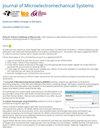溅射氮化钪铝的毫米波薄膜体声谐振器
IF 2.5
3区 工程技术
Q2 ENGINEERING, ELECTRICAL & ELECTRONIC
引用次数: 2
摘要
本文报道了一种基于溅射氮化钪铝(ScAlN)的毫米波(mmWave)薄膜体声谐振器(FBAR)。本文明确了将溅射ScAlN转换成毫米波频率的挑战,提出了一种在Al - on - Si载流子晶片上溅射Sc0.3 Al0.7 N的堆叠和新的制造工艺。该谐振器在21.4 GHz的一阶对称(S1)模式下实现了7.0%的机电耦合(${k} ^{2}$)和62的品质因子(${Q}$),在55.4 GHz的三阶对称(S3)模式下实现了${k} ^{2}$ 4.0%和${Q}$ 19,显示出比基于AlN/ scaln的毫米波声学谐振器更高的品质值(FoM, ${k} ^{2} \cdot {Q}$)。通过透射电子显微镜(TEM)和x射线衍射(XRD)对ScAlN的质量进行了鉴定,确定了现有压电-金属堆叠中的瓶颈。进一步改进ScAlN/ aln基毫米波声学谐振器需要改进薄膜沉积方法以获得更好的晶体质量。(2023 - 0151)本文章由计算机程序翻译,如有差异,请以英文原文为准。
Millimeter Wave Thin-Film Bulk Acoustic Resonator in Sputtered Scandium Aluminum Nitride
This work reports a millimeter wave (mmWave) thin-film bulk acoustic resonator (FBAR) in sputtered scandium aluminum nitride (ScAlN). This paper identifies challenges of frequency scaling sputtered ScAlN into mmWave and proposes a stack and new fabrication procedure with a sputtered Sc0.3 Al0.7 N on Al on Si carrier wafer. The resonator achieves electromechanical coupling (
${k} ^{2}$
) of 7.0% and quality factor (
${Q}$
) of 62 for the first-order symmetric (S1) mode at 21.4 GHz, along with
${k} ^{2}$
of 4.0% and
${Q}$
of 19 for the third-order symmetric (S3) mode at 55.4 GHz, showing higher figures of merit (FoM,
${k} ^{2} \cdot {Q}$
) than reported AlN/ScAlN-based mmWave acoustic resonators. The ScAlN quality is identified by transmission electron microscopy (TEM) and X-ray diffraction (XRD), identifying the bottlenecks in the existing piezoelectric-metal stack. Further improvement of ScAlN/AlN-based mmWave acoustic resonators calls for better crystalline quality from improved thin-film deposition methods. [2023-0151]
求助全文
通过发布文献求助,成功后即可免费获取论文全文。
去求助
来源期刊

Journal of Microelectromechanical Systems
工程技术-工程:电子与电气
CiteScore
6.20
自引率
7.40%
发文量
115
审稿时长
7.5 months
期刊介绍:
The topics of interest include, but are not limited to: devices ranging in size from microns to millimeters, IC-compatible fabrication techniques, other fabrication techniques, measurement of micro phenomena, theoretical results, new materials and designs, micro actuators, micro robots, micro batteries, bearings, wear, reliability, electrical interconnections, micro telemanipulation, and standards appropriate to MEMS. Application examples and application oriented devices in fluidics, optics, bio-medical engineering, etc., are also of central interest.
 求助内容:
求助内容: 应助结果提醒方式:
应助结果提醒方式:


